Struggling to find the right fabric for your golf apparel line? The wrong choice leads to uncomfortable, underperforming shirts that can hurt your brand. It’s a common but costly mistake.
The best golf polo fabrics are synthetics like polyester for superior moisture-wicking and durability. A small amount of spandex (3-5%) is essential for 4-way stretch. Lightweight, breathable materials ensure comfort and peak performance on the course without feeling heavy or restrictive.

Choosing the right material is the foundation of a great golf shirt. I have spent years working with fabrics, and I can tell you that every detail matters, from the fiber content to the final finish. This guide will walk you through everything I have learned, helping you make the best choice for your brand and your customers. Let's break it down so you feel confident in your selection.
How do you understand the fundamentals of golf shirt fabrics?
Feeling lost in all the fabric terminology? This confusion can lead to picking a material that doesn't perform well, which is a bad look for any activewear brand.
To start, focus on the difference between natural and synthetic fibers. Synthetics like polyester are built for performance, while cotton offers a classic feel. The right blend and weight are crucial for creating a shirt that works in specific weather conditions.

In my experience manufacturing apparel, the base fiber is the most important decision. A great design on the wrong fabric will always fail. We need to look at three core things: the fiber type, the common fabric options, and how heavy the material feels.
1. Natural vs. Synthetic Fiber Comparison
Natural fibers like cotton are soft and breathable but absorb moisture, becoming heavy and sticky with sweat. Synthetic fibers like polyester were engineered to solve this problem. They pull moisture away from the skin, a process we call moisture-wicking.
| Feature | Natural Fiber (e.g., Cotton) | Synthetic Fiber (e.g., Polyester) |
|---|---|---|
| Moisture | Absorbs sweat, gets heavy | Wicks sweat, stays dry |
| Durability | Moderate | High, resists shrinking/stretching |
| Wrinkles | Prone to wrinkling | Wrinkle-resistant |
| Feel | Soft, classic | Smooth, technical |
2. Common Golf-Specific Fabric Types
Most modern golf shirts use polyester or a polyester-spandex blend. Polyester provides the durability and moisture-wicking, while spandex adds stretch. Some brands still use cotton or cotton-poly blends for a more casual, off-course style, but for performance, synthetics are king.
3. Ideal Fabric Weights for Different Climates
Fabric weight, measured in Grams per Square Meter (GSM), is critical. A lightweight fabric (130-150 GSM) is perfect for hot, humid days. A midweight fabric (160-180 GSM) works for most conditions. Heavyweight fabrics (190+ GSM) are best for cool weather. Choosing a lightweight but durable material is my top recommendation.
What performance-enhancing fabric technologies should you look for?
Is your current golf shirt holding your customers back? A basic polo traps sweat and heat, and it can restrict a powerful swing. This discomfort ruins focus and performance.
The best performance shirts have three core technologies. First, moisture-wicking materials to keep you dry. Second, a high UPF rating for sun protection. Third, 4-way stretch fabric that moves with your body for a completely free swing.
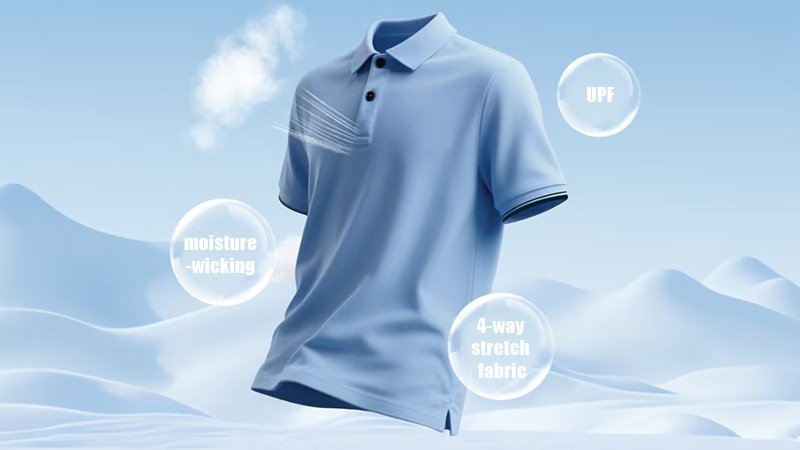
After selecting the base fabric, we can look at the treatments and properties that turn a good shirt into a great one. These technologies are not just marketing buzzwords; they provide real, tangible benefits on the golf course. I always advise my clients to prioritize these features.
1. Moisture-Wicking and Breathable Materials
Moisture-wicking is non-negotiable for high-performance golf apparel. The fabric actively pulls sweat from your skin to the shirt's outer surface, where it can evaporate quickly. This keeps the golfer dry, cool, and comfortable. Breathability goes hand-in-hand, allowing air to circulate and prevent overheating. Polyester is the champion of moisture-wicking.
2. UV Protection Standards (UPF Ratings)
Golfers spend hours in the sun. A shirt with a good Ultraviolet Protection Factor (UPF) rating acts like sunscreen for the skin it covers. I recommend looking for fabrics with a UPF of 30 or higher.
| UPF Rating | Protection Level |
|---|---|
| 15-24 | Good |
| 25-39 | Very Good |
| 40-50+ | Excellent |
3. 4-Way Stretch for Complete Mobility
A golf swing is a complex, athletic motion. The shirt should not get in the way. This is where stretch comes in. A fabric with 4-way stretch moves up, down, left, and right with the body. We achieve this by blending 3-5% spandex into the polyester base. This small addition makes a huge difference in comfort and freedom of movement.
How do you select the right fabric based on the climate?
Ever worn the wrong shirt for the day's weather? A heavy polo on a hot day is miserable, while a thin shirt on a windy day is just as bad.
For hot and humid conditions, choose lightweight polyester that is highly breathable. For cool or windy days, a slightly heavier knit provides warmth without bulk. Polyester-spandex blends are versatile enough to handle a wide range of temperatures, making them a safe all-weather option.
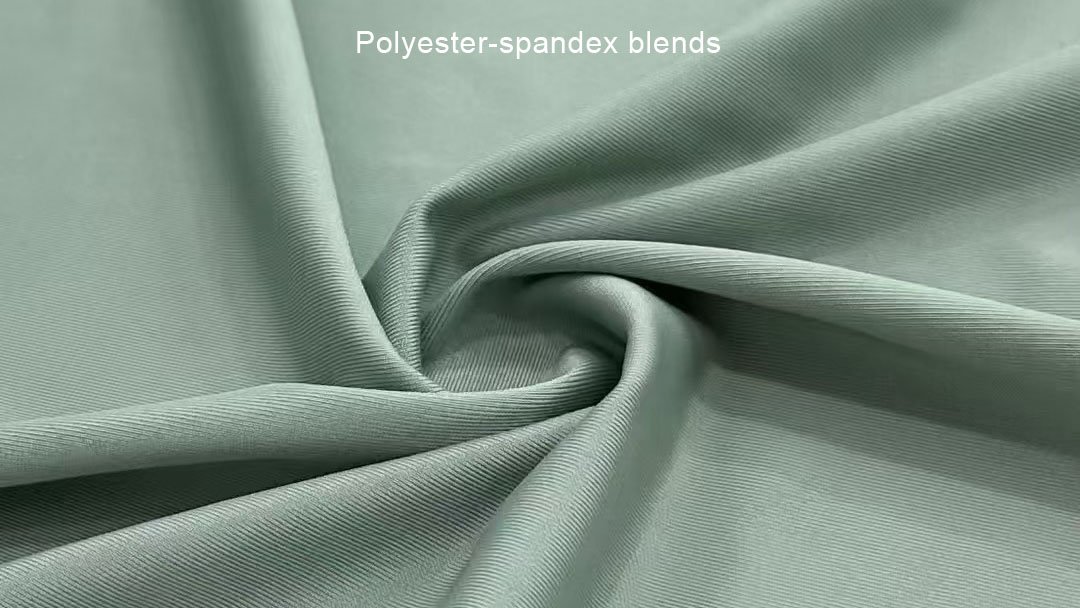
Thinking about where your customers will play is crucial. A brand in Florida needs different fabrics than a brand in Scotland. At my company, we always start the conversation by asking about the target climate. It directs our entire fabric sourcing process.
1. Best Fabrics for Hot & Humid Conditions
In the heat, you need to maximize breathability and moisture-wicking. Look for:
- Fabric: 100% Polyester or Polyester-Spandex blend (around 95/5).
- Weight: Lightweight, around 130-150 GSM.
- Weave: A jersey or piqué knit with a micro-perforated or mesh-like texture can enhance airflow. These designs are specifically made to keep the body cool.
2. Optimal Choices for Cool/Windy Environments
For cooler days, the goal is to trap a small amount of body heat without causing overheating. A long-sleeve polo works well here.
- Fabric: Polyester blend, sometimes with a brushed interior for softness and warmth.
- Weight: Midweight to heavyweight, around 170-200 GSM.
- Features: A tighter knit will help block wind. Some fabrics have a wind-resistant finish.
3. All-Weather Versatile Options
If you’re building a core collection, you need a shirt that works almost anywhere. This is where a mid-weight blend shines.
- Fabric: A 92% Polyester / 8% Spandex blend is a popular and effective choice.
- Weight: Midweight, around 160-175 GSM.
- Benefit: This fabric is substantial enough for a mild day but breathable enough for when the sun comes out. It provides the perfect balance for the average golfer.
What should you consider for quality and durability in a golf shirt?
Are your brand's polos fading or losing shape after just a few washes? Poor quality reflects badly on your business and disappoints customers who expect performance gear to last.
High quality comes from a dense fabric with a good thread count. Look for value-added treatments that make the fabric resistant to pilling and fading. Finally, always check for reinforced stitching in high-stress areas like the collar, placket, and side seams.
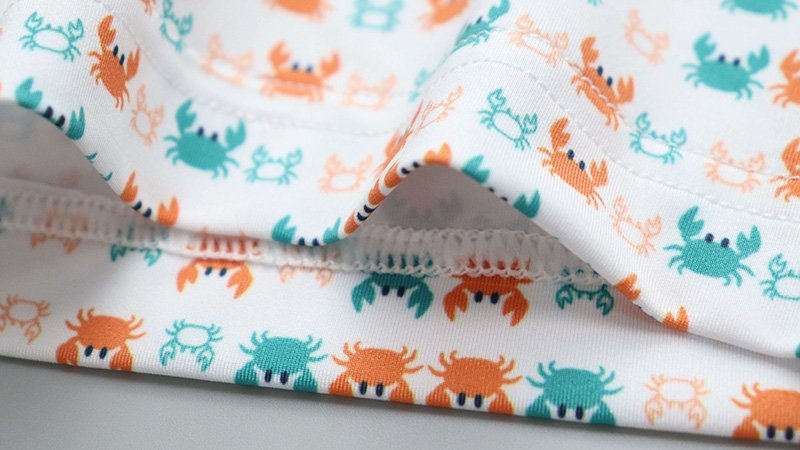
A great shirt must last. I've built my reputation on creating garments that stand up to repeated wear and washing. Quality isn't just about how the fabric feels when it's new; it's about how it performs over time. Let's look at the markers of a well-made, durable fabric.
1. Thread Count and Fabric Density
While thread count is often associated with bedding, the principle applies here too. A denser knit means the fabric is more stable and less likely to snag or lose its shape. It also tends to feel more premium. You don't need a specific number, but you can feel the difference. A flimsy, see-through fabric is a sign of low density and poor quality.
2. Anti-Pilling and Fade-Resistant Treatments
Pilling—those tiny balls of fiber that appear on a shirt's surface—makes a garment look old and cheap. High-quality polyester is naturally resistant to pilling, but an "anti-pill" finish provides extra security. Similarly, color-locking or fade-resistant treatments ensure the shirt looks vibrant even after many hours in the sun and cycles in the wash.
3. Reinforced Stitching Areas
The construction of the shirt is as important as the fabric itself. I always inspect key stress points. The collar should keep its shape, the placket (where the buttons are) must lay flat, and the shoulder seams need to be strong. Look for double-stitching, bar tacks, or other reinforcement techniques. These small details are the signature of a durable garment.
How do you analyze the price versus performance of golf shirt fabrics?
Feeling confused by the wide range of fabric prices? Paying too much for advanced technology you don't need hurts your bottom line. But cutting costs too much can result in a low-quality product.
Premium, tournament-grade fabrics offer the best technology but come at a high cost. Mid-range options give you a great balance of performance and value, perfect for most brands. Budget fabrics work for promotional items but lack the durability for serious golf.

As a business owner, you need to balance quality with cost. My job is to help clients understand what they are paying for. Not everyone needs the most expensive fabric on the market. The key is to match the fabric's price and performance to your brand's goals and your customer's expectations.
1. Premium Tournament-Grade Fabrics
These are the fabrics used by professional tour players. They often feature proprietary technology from big brands, like unique cooling yarns or extreme lightweight construction.
- Characteristics: Highest moisture-wicking, lightest weight, best stretch, often with antibacterial finishes.
- Price: High.
- Best For: High-end brands targeting serious, competitive golfers.
2. Mid-Range Practice Shirt Options
This is the sweet spot for most direct-to-consumer brands. These fabrics deliver excellent performance without the premium price tag.
- Characteristics: Solid polyester/spandex blends, effective moisture-wicking and UPF protection, good durability.
- Price: Moderate.
- Best For: Core collections, club merchandise, and brands focused on delivering great value.
3. Budget-Friendly Alternatives
These fabrics are usually 100% polyester with basic performance features. They get the job done but may not feel as soft or last as long.
- Characteristics: Basic moisture-wicking, minimal stretch, lower durability.
- Price: Low.
- Best For: Promotional events, staff uniforms, or entry-level product lines.
| Tier | Performance | Price | Best Use Case |
|---|---|---|---|
| Premium | Excellent | High | Elite Brands, Pro Shops |
| Mid-Range | Very Good | Moderate | Core Collections, Most Brands |
| Budget | Good | Low | Giveaways, Promotional Use |
How should you care for golf shirts based on their fabric type?
Do your performance polos lose their features after a few washes? Improper care can ruin expensive fabrics by clogging the pores that provide moisture-wicking and breathability.
Always wash synthetic polos in cold water. Never use fabric softener. For best results, hang them to dry or tumble dry on the lowest heat setting. Store them folded neatly in a drawer instead of on a hanger to prevent stretching.
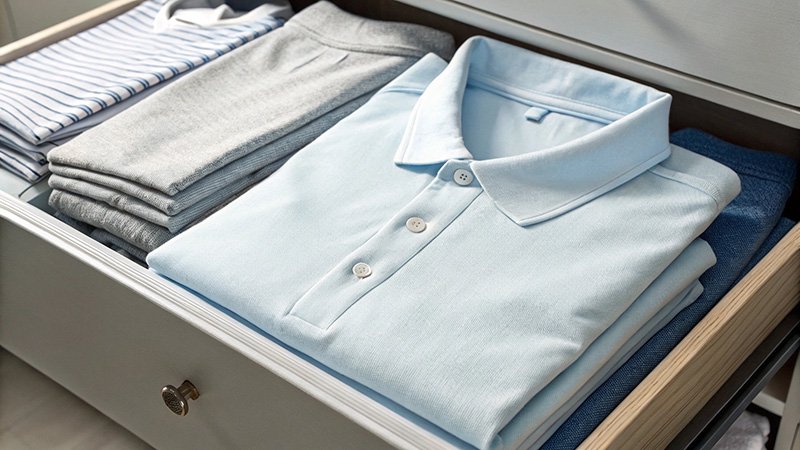
Once you've invested in quality fabrics for your brand, you want them to last. Educating your customers on proper care is a great way to add value. The instructions are simple, but they are very important for preserving the performance technologies we've talked about.
1. Washing Recommendations
The golden rule for performance synthetics is to wash them with other synthetics in cold water. Hot water can damage the delicate fibers and finishes over time. Most importantly, avoid fabric softeners and dryer sheets at all costs. They leave a waxy residue that clogs the fabric's pores, destroying its ability to wick moisture. Use a mild detergent and that's it.
2. Drying Best Practices
Heat is the enemy of spandex and other performance fibers. High heat from a dryer can cause the fabric to lose its stretch and shape. The best method is to hang the shirt to dry. Performance fabrics dry very quickly on their own. If you must use a machine, select the tumble dry low or air-dry setting, and remove the shirt as soon as it's done.
3. Storage Tips for Longevity
While it seems simple, how you store the shirt matters. Hanging a knit polo, especially a stretchy one, can cause the shoulders and length to stretch out over time due to gravity. The best way to store them is to fold them neatly and keep them in a drawer. This helps the shirt maintain its intended shape and fit.
Are there any special considerations when choosing a fabric?
Looking for a way to make your brand stand out? A standard polo might not be enough in today's market. Customers are now looking for brands that align with their values.
Consider using eco-friendly materials like recycled polyester to appeal to a growing market of conscious consumers. Antibacterial treatments are another great feature, as they help control odor during a long day on the course. Pushing for these innovations helps define your brand.

Beyond the core essentials, there are other innovations that can set your apparel apart. I am always excited when a client wants to explore these options because it shows they are thinking about the future. It's a way to connect with customers on a deeper level.
1. Eco-Friendly/Sustainable Options
Sustainability is becoming more important to consumers every year. The most common sustainable option in sportswear is recycled polyester, often called rPET. It is made from post-consumer plastic bottles. The performance of rPET is identical to virgin polyester, but it uses significantly less energy and resources to produce. Offering a sustainable collection can be a powerful part of your brand story.
2. Antibacterial/Odor-Control Technologies
Nobody wants to be the person with a smelly shirt in the clubhouse. Antibacterial finishes work by inhibiting the growth of odor-causing bacteria that thrive in sweat. This is often done by embedding silver ions or other antimicrobial agents into the fabric. The shirt stays fresher for longer, which is a big benefit for golfers.
3. Brand-Specific Fabric Innovations
Many large apparel brands invest heavily in research and development to create their own proprietary fabrics. They give them unique names and market them heavily. As a manufacturer, I can tell you that we can often source or develop fabrics with very similar properties. Don't be intimidated by fancy marketing terms; focus on the actual performance characteristics we've discussed.
What's the final checklist for selecting the perfect golf polo fabric?
Feeling ready to choose but worried you might forget something? Making the final decision can be stressful. Overlooking one key detail could result in a product that doesn't meet expectations.
Your final check should cover three areas. First, comfort: is it soft and light? Second, performance: does it wick moisture and stretch? And third, style: does it drape well and fit your brand's aesthetic?
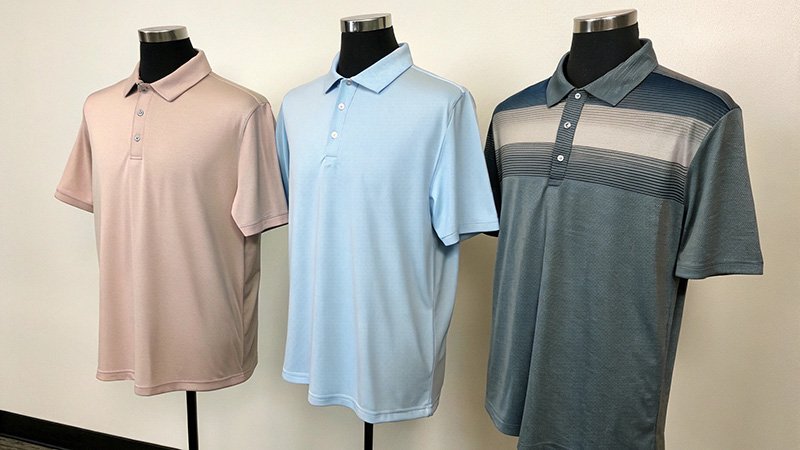
After absorbing all this information, it's helpful to have a simple checklist. When I am evaluating a new fabric for a client, I run through these final points to make sure it ticks all the boxes. This ensures we have a balanced fabric that looks, feels, and performs perfectly.
Here is a simplified version of the checklist I use. Go through it before you make your final decision.
1. Comfort Evaluation Criteria
This is about how the fabric feels against the skin.
- Soft Hand-Feel? Is it smooth and non-irritating?
- Lightweight? Does it feel light and airy, not heavy or bulky?
- Breathable? Can air pass through it easily? Hold it up to a light to check the weave.
2. Performance Must-Haves
This is about what the fabric does.
- Moisture-Wicking? Is it 100% synthetic or a high-polyester blend?
- Good Stretch? Does it stretch in all four directions? (Check for 3-8% spandex content).
- UPF Protection? Does the supplier specify a UPF rating of 30 or more?
3. Style & Fit Considerations
This is about how the fabric looks and wears.
- Good Drape? Does it hang nicely on the body without clinging?
- Colorfast/Anti-Pill? Are these finishes included for longevity?
- Fits Brand Aesthetic? Does the fabric's look and feel (e.g., matte vs. sheen) match your brand image?
Conclusion
Choosing the right fabric is a balance of performance, comfort, and cost. Get it right, and you create a polo that enhances the game and builds a great reputation.
.png)
